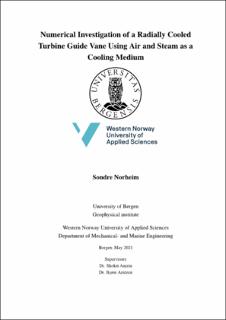Numerical Investigation of a Radially Cooled Turbine Guide Vane Using Air and Steam as a Cooling Medium
Master thesis
Permanent lenke
https://hdl.handle.net/11250/2760950Utgivelsesdato
2021-06-01Metadata
Vis full innførselSamlinger
- Master theses [105]
Sammendrag
Gas turbine performance is closely linked to the turbine inlet temperature, which in turn is limited by the turbine guide vanes ability to withstand the massive thermal loads. To improve the efficiency in modern high-temperature gas turbines, steam cooling has been introduced as a new advanced cooling technique. This study compares the cooling performance of compressed air and steam in the renowned radially cooled NASA C3X turbine guide vane, using a numerical model. The conjugate heat transfer (CHT) model is based on the RANS-method, where the shear stress transport (SST) k−ω model is selected to predict the effects of turbulence. The numerical model is validated against experimental pressure and temperature distributions at the external surface of the vane, where air is used as coolant. The results are in good agreement with the experimental data, with an average error of 1.39% and 3.78%, respectively. By comparing the numerical simulations of the two coolants, steam is confirmed as the superior cooling medium. The disparity between the coolants increases along the axial direction of the vane, and the total volume average temperature difference is 30 K. Further investigations are recommended to deal with the local hot-spots located near the leading- and trailing edge of the vane.
